This HOWTO describes how to combine two standard AIX technologies that can be used to simplify centralized collection and distribution of software updates for AIX.
Rather than use SUMA on every system I setup SUMA on separate systems based on their level of AIX - AIX 5.3 and AIX 6.1. As no new TL or SP are planned for AIX 5.2 and I am phasing AIX 5.2 out I am not using this process for updating the one or two AIX 5.2 systems. For all others I now use SUMA to collect updates and distribute them to other systems via a software server. And since I like pushing resources, I have integrated SUMA into my NIM resources. I'll discuss the how and why below.
And then IBM changed the way FixCentral works - and now it was hard to do things the way I was accustommed to. And so SUMA became more than just another way! SUMA became the way - well, after I finally bit the bullet and took a serious look at SUMA.
The first step is configure SUMA. I try to avoid the defaults - you never know when defaults change and I rarely find them fit my situation.
# smit suma
brings us to the openingscreen.
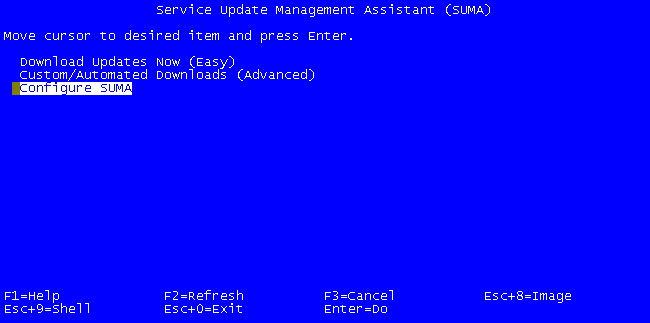
The main screen I am interested in is the Task Defaults - because here I change /usr/sys/inst.images to my preferred location. One of my "defaults" is to avoid putting anything in /usr whenever possible.
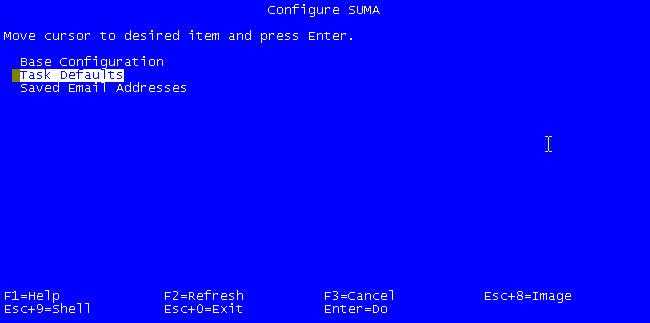
So I have changed it to a seperate volume group - and have the files placed in /data/suma. (By the way, you probably need to be root to go further - almost forgot to mention that!)

So, with the small change to /data/suma I am ready to go.
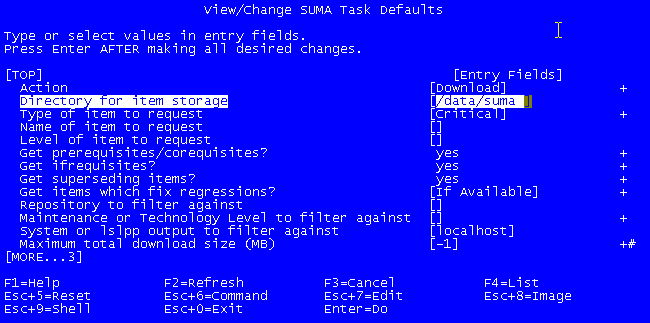
Back at the main screen, choose the Download Updates Now (Easy).
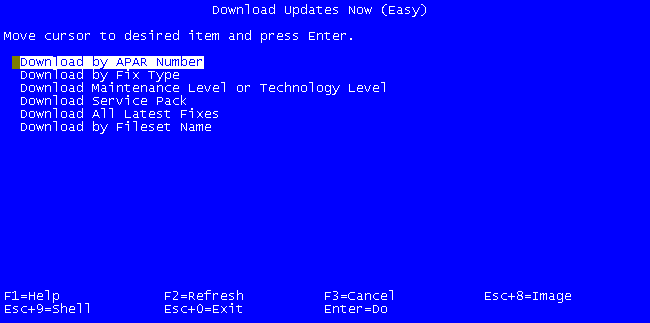
I use separate systems - i.e. not the NIM server - so it is easier to manage multiple TL and CSP levels. On this system I am running AIX 5.3 TL07. To check on the latest releases I went to the ROOTVg bookmark section "Service Bulletins" and choose the link for AIX 5.3 TL07 notices .This opens a subscription service page on IBM Systems Support. I chose the latest service pack entry and get an APAR number from the text
In the APAR screen I enter the APAR Number I copied: IZ15487 and press enter. SUMA keeps track of what I have already downloaded so I only download what I do not already have at this APAR level. So, along with all the downloads, there are lines like these:

This pretty much takes care of getting the updates. What about applying them?
Note - the machine serving the resource is not the master nim server, but a client machine (here x054).
root@nim:[/]lsnim -l lpp_5307_suma
lpp_5307_suma:
class = resources
type = lpp_source
comments = SUMA maintained updates for AIX 5307
arch = power
Rstate = ready for use
prev_state = unavailable for use
location = /data/suma
alloc_count = 0
server = x054
So, on the nim server I can use the update option to push updates to nim clients as well as update the nim master. However, when I do an update I get a message about Superseded Filesets.
Superseded Fileset Updates
--------------------------
Fileset updates listed in this section will not be installed.
Newer updates which supersede (replace) these were selected instead (either by
you or automatically by theinstallation program). Make sure that the
superseding updates listed passed pre-installation verification.
This is a common occurance when you just keep downloading updates. Fortunately, IBM developed a program for AIX to assist NIM with managing lpp_sources. This program is called lppmgr. You can use this command from the command line, but it is very easy to use via smit as well.
The fast path is: smit nim_lppmgr
So we choose the lpp_source of interest....
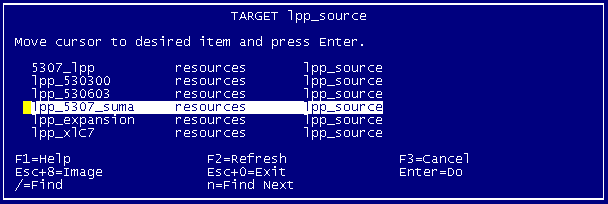
And we get this dialog: Note: by default, it is a preview operation. When you switch that to "Preview-> no" the default action is to delete the filesets. You can save these in a an alturnate location. In terms of lppmgr command syntax this is a move operation. For your first time - I suggest performing the preview.
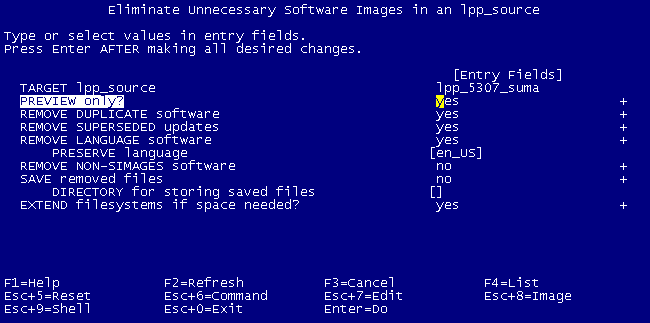
You will probably get something similar to this:
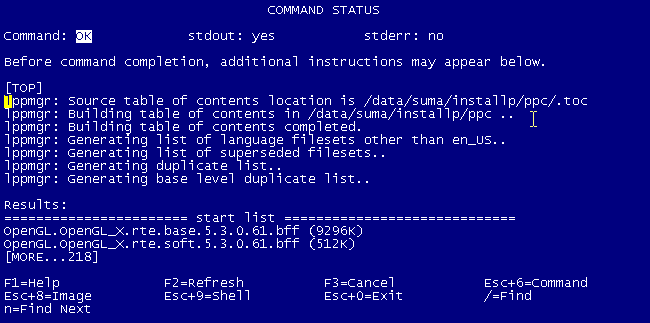
I hopes this helps you with managing your AIX software updates
Rather than use SUMA on every system I setup SUMA on separate systems based on their level of AIX - AIX 5.3 and AIX 6.1. As no new TL or SP are planned for AIX 5.2 and I am phasing AIX 5.2 out I am not using this process for updating the one or two AIX 5.2 systems. For all others I now use SUMA to collect updates and distribute them to other systems via a software server. And since I like pushing resources, I have integrated SUMA into my NIM resources. I'll discuss the how and why below.
Step 1: Collecting updates using SUMA
For years I have just downloaded filesets and/or compressed tar files of AIX updates. For a few years there has been an alturnate solution - SUMA, or Service UpdateManagement Assistant. I liked the fileset approach because I had done it that way since I got started and try not to change just for the sake of change. SUMA (I kept telling myself) is just another interface.And then IBM changed the way FixCentral works - and now it was hard to do things the way I was accustommed to. And so SUMA became more than just another way! SUMA became the way - well, after I finally bit the bullet and took a serious look at SUMA.
Preparation
SUMA is setup using smit. Although you can set it up to be fully automated via cron I continue using it via smit. Automated updates could be handy for critical fixes but for my goal of centralized update management the focus is on TL (technology level) and and SP (service pack) collections.The first step is configure SUMA. I try to avoid the defaults - you never know when defaults change and I rarely find them fit my situation.
# smit suma
brings us to the openingscreen.

The main screen I am interested in is the Task Defaults - because here I change /usr/sys/inst.images to my preferred location. One of my "defaults" is to avoid putting anything in /usr whenever possible.

So I have changed it to a seperate volume group - and have the files placed in /data/suma. (By the way, you probably need to be root to go further - almost forgot to mention that!)

So, with the small change to /data/suma I am ready to go.

Back at the main screen, choose the Download Updates Now (Easy).

I use separate systems - i.e. not the NIM server - so it is easier to manage multiple TL and CSP levels. On this system I am running AIX 5.3 TL07. To check on the latest releases I went to the ROOTVg bookmark section "Service Bulletins" and choose the link for AIX 5.3 TL07 notices .This opens a subscription service page on IBM Systems Support. I chose the latest service pack entry and get an APAR number from the text
In the APAR screen I enter the APAR Number I copied: IZ15487 and press enter. SUMA keeps track of what I have already downloaded so I only download what I do not already have at this APAR level. So, along with all the downloads, there are lines like these:

This pretty much takes care of getting the updates. What about applying them?
Step 2: Integrating SUMA downloads into NIM resources
On my NIM server I create a lpp_source that points at /data/suma on the system doing the downloads.Note - the machine serving the resource is not the master nim server, but a client machine (here x054).
root@nim:[/]lsnim -l lpp_5307_suma
lpp_5307_suma:
class = resources
type = lpp_source
comments = SUMA maintained updates for AIX 5307
arch = power
Rstate = ready for use
prev_state = unavailable for use
location = /data/suma
alloc_count = 0
server = x054
So, on the nim server I can use the update option to push updates to nim clients as well as update the nim master. However, when I do an update I get a message about Superseded Filesets.
Superseded Fileset Updates
--------------------------
Fileset updates listed in this section will not be installed.
Newer updates which supersede (replace) these were selected instead (either by
you or automatically by theinstallation program). Make sure that the
superseding updates listed passed pre-installation verification.
This is a common occurance when you just keep downloading updates. Fortunately, IBM developed a program for AIX to assist NIM with managing lpp_sources. This program is called lppmgr. You can use this command from the command line, but it is very easy to use via smit as well.
The fast path is: smit nim_lppmgr
So we choose the lpp_source of interest....

And we get this dialog: Note: by default, it is a preview operation. When you switch that to "Preview-> no" the default action is to delete the filesets. You can save these in a an alturnate location. In terms of lppmgr command syntax this is a move operation. For your first time - I suggest performing the preview.

You will probably get something similar to this:

I hopes this helps you with managing your AIX software updates
No comments:
Post a Comment